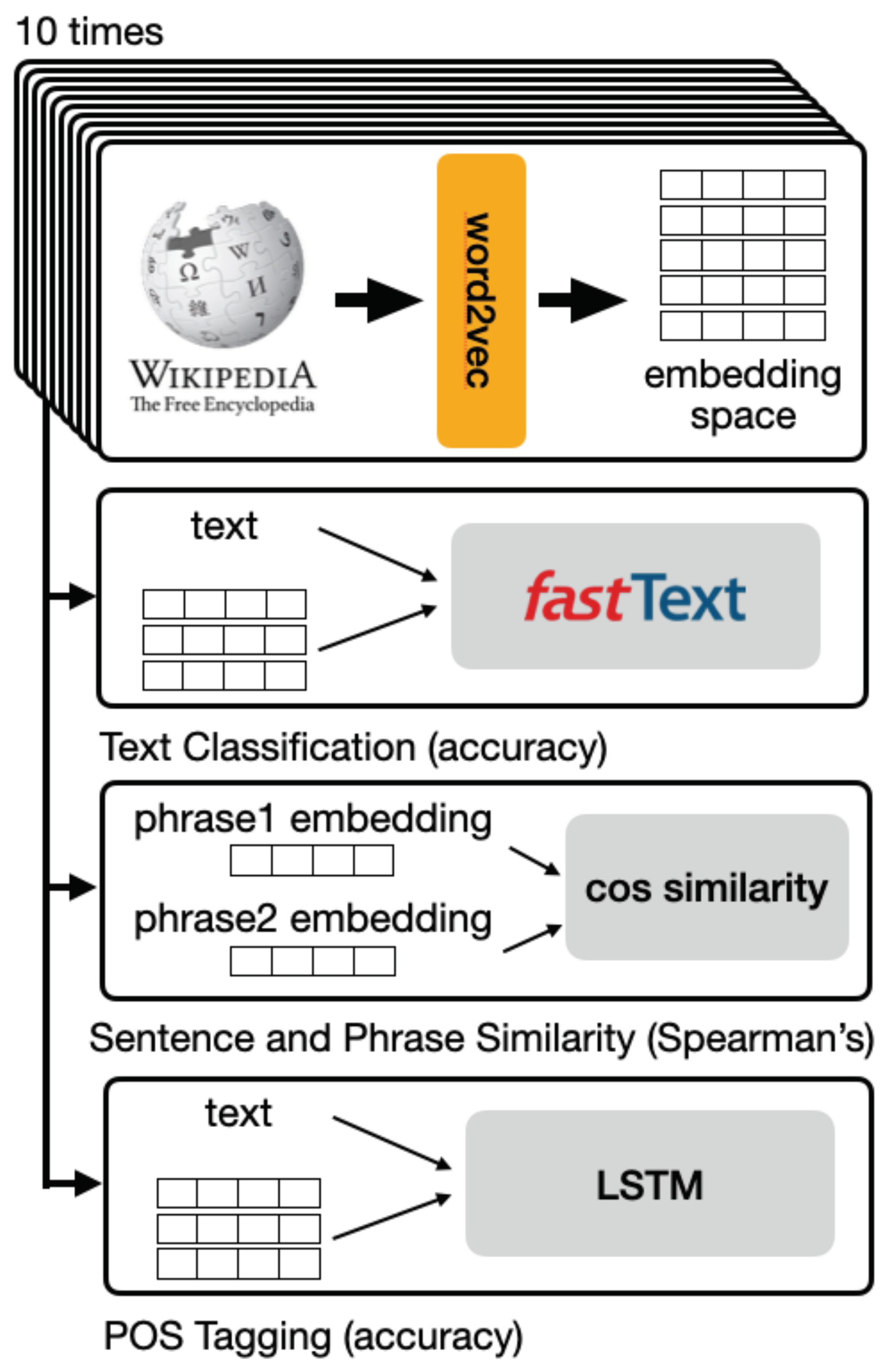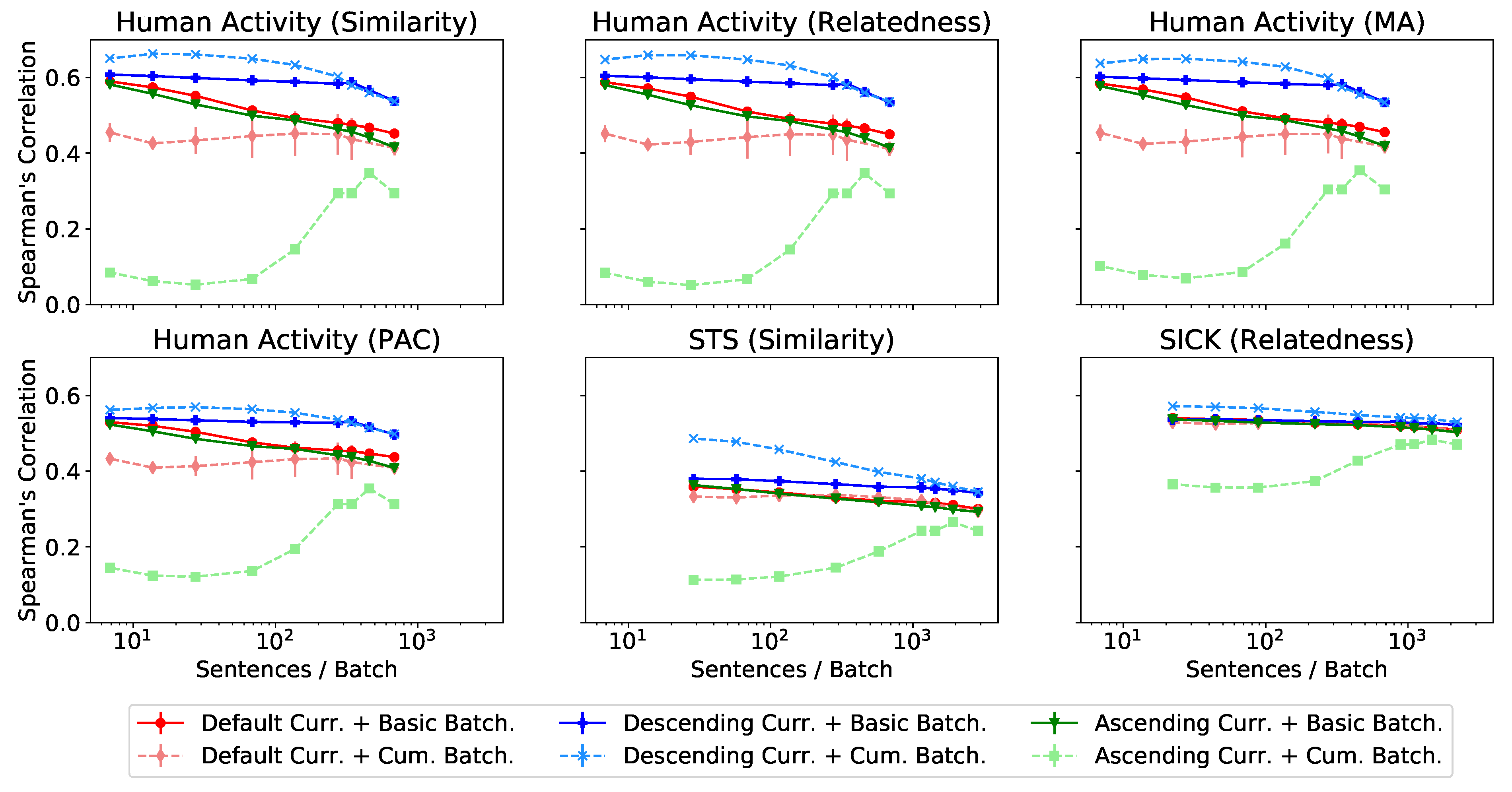To Batch or Not to Batch? Comparing Batching and Curriculum Learning Strategies across Tasks and Datasets
Abstract
:1. Introduction
2. Related Work
2.1. Word Embeddings
2.2. Batching
2.3. Curriculum Learning
3. Materials and Methods
3.1. Initial Embedding Spaces
3.2. Batching
3.2.1. Basic Batching
3.2.2. Cumulative Batching
3.3. Curriculum Learning
3.4. Task 1: Text Classification
3.5. Task 2: Sentence and Phrase Similarity
3.6. Task 3: Part-of-Speech Tagging
4. Results
4.1. Task 1: Text Classification
4.2. Task 2: Sentence and Phrase Similarity
4.3. Task 3: Part-of-Speech Tagging
5. Conclusions
6. Future Work
Author Contributions
Funding
Institutional Review Board Statement
Informed Consent Statement
Data Availability Statement
Conflicts of Interest
References
- Mikolov, T.; Sutskever, I.; Chen, K.; Corrado, G.S.; Dean, J. Distributed representations of words and phrases and their compositionality. In Proceedings of the Advances in Neural Information Processing Systems, Lake Tahoe, NA, USA, 5–10 December 2013; pp. 3111–3119. [Google Scholar]
- Mikolov, T.; Chen, K.; Corrado, G.; Dean, J. Efficient estimation of word representations in vector space. arXiv 2013, arXiv:1301.3781. [Google Scholar]
- Collobert, R.; Weston, J.; Bottou, L.; Karlen, M.; Kavukcuoglu, K.; Kuksa, P. Natural language processing (almost) from scratch. J. Mach. Learn. Res. 2011, 12, 2493–2537. [Google Scholar]
- Kenter, T.; de Rijke, M. Short Text Similarity with Word Embeddings. In Proceedings of the 24th ACM International on Conference on Information and Knowledge Management, Melbourne, Australia, 19–23 October 2015; Association for Computing Machinery: New York, NY, USA, 2015. CIKM ’15. pp. 1411–1420. [Google Scholar] [CrossRef] [Green Version]
- Faruqui, M.; Dodge, J.; Jauhar, S.K.; Dyer, C.; Hovy, E.; Smith, N.A. Retrofitting Word Vectors to Semantic Lexicons. In Proceedings of the 2015 Conference of the North American Chapter of the Association for Computational Linguistics: Human Language Technologies, Denver, CO, USA, 31 May–5 June 2015; Association for Computational Linguistics: Stroudsburg, PA, USA, 2019; pp. 1606–1615. [Google Scholar] [CrossRef]
- Mikolov, T.; Le, Q.V.; Sutskever, I. Exploiting similarities among languages for machine translation. arXiv 2013, arXiv:1309.4168. [Google Scholar]
- Bengio, Y.; Louradour, J.; Collobert, R.; Weston, J. Curriculum learning. In Proceedings of the International Conference on Machine Learning, Montreal, QC, Canada, 14–18 June 2009; pp. 41–48. [Google Scholar]
- Spitkovsky, V.I.; Alshawi, H.; Jurafsky, D. From Baby Steps to Leapfrog: How “Less is More” in Unsupervised Dependency Parsing. In Proceedings of the Human Language Technologies: The 2010 Annual Conference of the North American Chapter of the Association for Computational Linguistics, Los Angeles, CA, USA, 2–4 June 2010; Association for Computational Linguistics: Stroudsburg, PA, USA, 2019; pp. 751–759. [Google Scholar]
- Smith, S.L.; Kindermans, P.J.; Ying, C.; Le, Q.V. Don’t decay the learning rate, increase the batch size. In Proceedings of the International Conference on Learning Representations, Vancouver, BC, Canada, 30 April–3 May 2018. [Google Scholar]
- Tsvetkov, Y.; Faruqui, M.; Ling, W.; MacWhinney, B.; Dyer, C. Learning the Curriculum with Bayesian Optimization for Task-Specific Word Representation Learning. In Proceedings of the 54th Annual Meeting of the Association for Computational Linguistics (Volume 1: Long Papers), Berlin, Germany, 7–12 August 2016; pp. 130–139. [Google Scholar]
- Xu, B.; Zhang, L.; Mao, Z.; Wang, Q.; Xie, H.; Zhang, Y. Curriculum Learning for Natural Language Understanding. In Proceedings of the 58th Annual Meeting of the Association for Computational Linguistics; Association for Computational Linguistics, Online, 5–10 July 2020; pp. 6095–6104. [Google Scholar] [CrossRef]
- Zhang, X.; Shapiro, P.; Kumar, G.; McNamee, P.; Carpuat, M.; Duh, K. Curriculum Learning for Domain Adaptation in Neural Machine Translation. In Proceedings of the 2019 Conference of the North American Chapter of the Association for Computational Linguistics: Human Language Technologies, Minneapolis, MN, USA, 2–9 June 2019; Association for Computational Linguistics: Stroudsburg, PA, USA, 2019; pp. 1903–1915. [Google Scholar] [CrossRef]
- Antoniak, M.; Mimno, D. Evaluating the Stability of Embedding-based Word Similarities. Tran. Assoc. Comput. Linguist. 2018, 6, 107–119. [Google Scholar] [CrossRef] [Green Version]
- Wendlandt, L.; Kummerfeld, J.K.; Mihalcea, R. Factors Influencing the Surprising Instability of Word Embeddings. In Proceedings of the 2018 Conference of the North American Chapter of the Association for Computational Linguistics: Human Language Technologies, New Orleans, LA, USA, 1–6 June 2018; Assocation for Computational Linguistics: Stroudsburg, PA, USA, 2019; pp. 2092–2102. [Google Scholar] [CrossRef]
- Zhang, X.; Zhao, J.; LeCun, Y. Character-level convolutional networks for text classification. In Proceedings of the Advances in Neural Information Processing Systems, Montreal, QC, Canada, 7–12 December 2015; pp. 649–657. [Google Scholar]
- Pérez-Rosas, V.; Abouelenien, M.; Mihalcea, R.; Burzo, M. Deception detection using real-life trial data. In Proceedings of the 2015 ACM on International Conference on Multimodal Interaction, Seattle, WA, USA, 9–13 November 2015; ACM: Seattle, WA, USA, 2015; pp. 59–66. [Google Scholar]
- Pérez-Rosas, V.; Mihalcea, R. Experiments in open domain deception detection. In Proceedings of the 2015 Conference on Empirical Methods in Natural Language Processing, Lisbon, Portugal, 17–21 September 2015; pp. 1120–1125. [Google Scholar]
- Loza, V.; Lahiri, S.; Mihalcea, R.; Lai, P.H. Building a Dataset for Summarization and Keyword Extraction from Emails. In Proceedings of the Ninth International Conference on Language Resources and Evaluation, Reykjavik, Iceland, 26–31 May 2014; European Languages Resources Association: Paris, France, 2014; pp. 2441–2446. [Google Scholar]
- Joulin, A.; Grave, E.; Bojanowski, P.; Mikolov, T. Bag of Tricks for Efficient Text Classification. In Proceedings of the 15th Conference of the European Chapter of the Association for Computational Linguistics, Valencia, Spain, 3–7 April 2017; Association for Computational Linguistics: Stroudsburg, PA, USA, 2017; pp. 427–431. [Google Scholar]
- Wilson, S.; Mihalcea, R. Measuring Semantic Relations between Human Activities. In Proceedings of the Eighth International Joint Conference on Natural Language Processing (Volume 1: Long Papers), Asian Federation of Natural Language Processing, Taipei, Taiwan, 27 November–1 December 2017; pp. 664–673. [Google Scholar]
- Cer, D.; Diab, M.; Agirre, E.; Lopez-Gazpio, I.; Specia, L. SemEval-2017 Task 1: Semantic Textual Similarity Multilingual and Crosslingual Focused Evaluation. In Proceedings of the 11th International Workshop on Semantic Evaluation, Vancouver, BC, Canada, 3–4 August 2017; Association for Computational Linguistics: Stroudsburg, PA, USA, 2017; pp. 1–14. [Google Scholar] [CrossRef]
- Bentivogli, L.; Bernardi, R.; Marelli, M.; Menini, S.; Baroni, M.; Zamparelli, R. SICK through the SemEval glasses. Lesson learned from the evaluation of compositional distributional semantic models on full sentences through semantic relatedness and textual entailment. Lang. Resour. Eval. 2016, 50, 95–124. [Google Scholar] [CrossRef]
- Spearman, C. Correlation calculated from faulty data. Br. J. Psychol. 1904–1920 1910, 3, 271–295. [Google Scholar] [CrossRef]
- Sedgwick, P. Pearson’s correlation coefficient. BMJ 2012, 345, e4483. [Google Scholar] [CrossRef] [Green Version]
- Nivre, J.; de Marneffe, M.C.; Ginter, F.; Goldberg, Y.; Hajič, J.; Manning, C.D.; McDonald, R.; Petrov, S.; Pyysalo, S.; Silveira, N.; et al. Universal Dependencies v1: A Multilingual Treebank Collection, Language Resources and Evaluation. In Proceedings of the Tenth International Conference on Language Resources and Evaluation, Portorož, Slovenia, 23–28 May 2016; European Languages Resources Association: Paris, France, 2016; pp. 1659–1666. [Google Scholar]
- Neubig, G.; Dyer, C.; Goldberg, Y.; Matthews, A.; Ammar, W.; Anastasopoulos, A.; Ballesteros, M.; Chiang, D.; Clothiaux, D.; Cohn, T.; et al. DyNet: The Dynamic Neural Network Toolkit. arXiv 2017, arXiv:1701.03980. [Google Scholar]
- Hochreiter, S.; Schmidhuber, J. Long Short-Term Memory. Neural Comput. 1997, 9, 1735–1780. [Google Scholar] [CrossRef] [PubMed]
- Devlin, J.; Chang, M.W.; Lee, K.; Toutanova, K. BERT: Pre-training of Deep Bidirectional Transformers for Language Understanding. In Proceedings of the 2019 Conference of the North American Chapter of the Association for Computational Linguistics: Human Language Technologies, Minneapolis, MN, USA, 2–9 June 2019; Association for Computational Linguistics: Stroudsburg, PA, USA, 2019; pp. 4171–4186. [Google Scholar]
- Pennington, J.; Socher, R.; Manning, C. GloVe: Global Vectors for Word Representation. In Proceedings of the 2014 Conference on Empirical Methods in Natural Language Processing, Association for Computational Linguistics, Doha, Qatar, 25–29 October 2014; pp. 1532–1543. [Google Scholar] [CrossRef]




| Dataset | # Sent. (Train) | # Sent. (Test) | # Classes |
|---|---|---|---|
| Amazon Review (pol.) | 2 | ||
| Amazon Review (full) | 5 | ||
| Yahoo! Answers | 10 | ||
| Yelp Review (full) | 5 | ||
| Yelp Review (pol.) | 2 | ||
| DBPedia | 14 | ||
| Sogou News | 5 | ||
| AG News | 7600 | 4 | |
| Open Domain Deception | 5733 | 1435 | 2 |
| Personal Email | 260 | 89 | 2 |
| Real Life Deception | 96 | 25 | 2 |
| Dataset | # Pairs (Train) | # Pairs (Test) | # Tokens (Train) |
|---|---|---|---|
| Human Activity | 1373 | 1000 | 1446 |
| STS Benchmark | 5749 | 1379 | 14,546 |
| SICK | 4439 | 4906 | 2251 |
| Dataset | # Sentences (Train) | # Sentences (Test) |
|---|---|---|
| UD Answers | 2631 | 438 |
| UD Email | 3770 | 606 |
| Human Activity | ||||||
|---|---|---|---|---|---|---|
| Dataset | Sim. | Rel. | MA | PAC | STS | SICK |
| Baseline | ||||||
| Best | ||||||
Publisher’s Note: MDPI stays neutral with regard to jurisdictional claims in published maps and institutional affiliations. |
© 2021 by the authors. Licensee MDPI, Basel, Switzerland. This article is an open access article distributed under the terms and conditions of the Creative Commons Attribution (CC BY) license (https://creativecommons.org/licenses/by/4.0/).
Share and Cite
Burdick, L.; Kummerfeld, J.K.; Mihalcea, R. To Batch or Not to Batch? Comparing Batching and Curriculum Learning Strategies across Tasks and Datasets. Mathematics 2021, 9, 2234. https://doi.org/10.3390/math9182234
Burdick L, Kummerfeld JK, Mihalcea R. To Batch or Not to Batch? Comparing Batching and Curriculum Learning Strategies across Tasks and Datasets. Mathematics. 2021; 9(18):2234. https://doi.org/10.3390/math9182234
Chicago/Turabian StyleBurdick, Laura, Jonathan K. Kummerfeld, and Rada Mihalcea. 2021. "To Batch or Not to Batch? Comparing Batching and Curriculum Learning Strategies across Tasks and Datasets" Mathematics 9, no. 18: 2234. https://doi.org/10.3390/math9182234
APA StyleBurdick, L., Kummerfeld, J. K., & Mihalcea, R. (2021). To Batch or Not to Batch? Comparing Batching and Curriculum Learning Strategies across Tasks and Datasets. Mathematics, 9(18), 2234. https://doi.org/10.3390/math9182234






